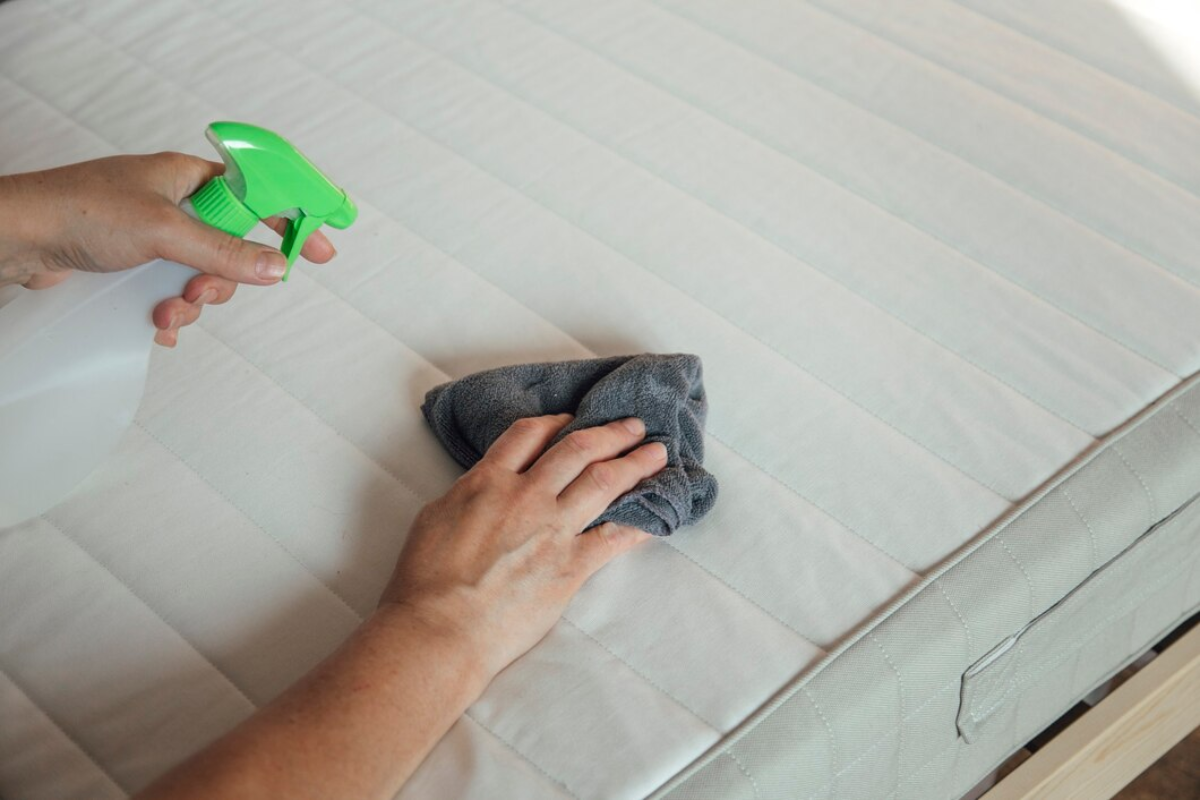If your mattress hasn’t had a proper cleaning in a while, you’re not alone. Most people forget that mattresses, just like any other part of your home, need regular care. Knowing how to clean a mattress can help you sleep better, reduce allergens, and extend the life of your bed. This guide walks you through the process in simple steps, using common household supplies and practical advice that works.
Why Mattress Cleaning Matters?
Your mattress is more than just a sleeping surface — it’s where your body rests and recharges. But over time, it also becomes a home for dust mites, dead skin cells, sweat, and bacteria. Without regular cleaning, these build up quietly and can affect both your health and your sleep quality.
Dust mites, in particular, are a common trigger for allergies. If you wake up with a runny nose, itchy eyes, or a sore throat, your mattress could be the reason. Bacteria and fungi can also thrive in a warm, damp mattress, especially if it’s never aired out. And let’s not forget odors. Lingering smells from sweat or spills make your bed feel less fresh, even if you wash your sheets often.
Cleaning your mattress helps reduce these unwanted guests. It freshens the fabric, neutralizes odors, and creates a healthier sleep space. It’s not just about being clean — it’s about comfort, health, and peace of mind.
How Often Should You Clean Your Mattress?
There’s no single rule for everyone, but most sleep experts agree: clean your mattress at least twice a year. That means once every six months as a general guideline.
However, your personal schedule might differ based on your lifestyle. If you have allergies or asthma, live in a humid climate, or share your bed with pets or kids, you’ll want to clean it more often — perhaps every 3–4 months.
Routine maintenance also plays a role. If you vacuum the surface regularly and use a mattress protector, deep cleaning won’t be needed as frequently. The key is consistency. Just like you wouldn’t wait months to clean your bathroom or kitchen, your mattress deserves the same kind of attention.
What You’ll Need Before You Start?
Before you learn how to clean a mattress step by step, gather the supplies that make the job easy and effective. You don’t need anything fancy — just a few simple items you likely already have at home.
A vacuum cleaner with an upholstery attachment is essential. You’ll also want some baking soda, which is great for neutralizing odors. A mild liquid detergent or dish soap helps with stain removal. Optional extras include hydrogen peroxide for tougher stains, a spray bottle for cleaning solution, and clean cloths or sponges for blotting.
If possible, have a sunny spot available for air drying. Fresh air and sunlight do wonders when it comes to refreshing mattress fabric naturally.
Step-by-Step Guide to Cleaning a Mattress
Whether it’s been a while or you’re doing a routine clean, this step-by-step process will show you exactly how to clean a mattress safely and thoroughly.
Vacuuming to Remove Surface Debris
Start by removing all bedding, including sheets, pillowcases, and mattress covers. Set those aside for washing.
Then, take your vacuum and use the upholstery attachment to clean the entire surface of the mattress. Go slowly to make sure you pick up dust, hair, crumbs, and loose debris. Don’t forget to vacuum along the edges and seams — these areas trap more than you’d expect.
Deodorizing with Baking Soda
Once vacuumed, sprinkle a thin, even layer of baking soda over the entire surface. Let it sit for at least 30 minutes — the longer, the better. Baking soda naturally absorbs odors and moisture, making your mattress feel fresher.
After waiting, vacuum up the baking soda thoroughly. This step alone can make a huge difference in how your mattress smells and feels.
Spot Cleaning Stains the Right Way
If you notice stains, deal with them right away using a gentle approach. Mix a small amount of mild detergent with warm water and dip a cloth into the solution. Blot the stain gently — don’t rub, as that can push the stain deeper.
For protein-based stains like blood or sweat, a mix of hydrogen peroxide and dish soap can be effective. Test a small area first to make sure it doesn’t bleach or damage the fabric.
Always use as little moisture as possible. Your goal is to lift the stain without soaking the mattress, which can lead to mold or mildew.
Air Drying and Sun Exposure Tips
Once you’re done cleaning, allow the mattress to air dry completely before putting any bedding back on. If you can, take advantage of a sunny window or move the mattress outside for a few hours. Sunlight helps eliminate lingering bacteria and odors.
Even if you clean with minimal water, moisture can linger — so give it time. A fully dry mattress is key to preventing mildew or musty smells.
How to Treat Common Mattress Stains?
Some stains are more stubborn than others. Knowing how to clean a mattress means being ready for the most common culprits.
Sweat stains can leave behind yellow patches and a stale odor. Baking soda and gentle blotting usually help. For urine stains, especially from pets or kids, use an enzyme-based cleaner that breaks down the proteins causing the smell.
Blood stains should be treated with cold water and hydrogen peroxide. Avoid hot water, which sets the stain. Food or drink spills require quick action — blot the area, apply a mild detergent solution, and dry thoroughly.
Acting fast is always the best approach. The longer a stain sits, the harder it becomes to remove.
Preventive Tips to Keep Your Mattress Clean Longer
The best way to deal with mattress cleaning is to prevent issues before they start. One of the easiest ways is to use a washable mattress protector. It acts as a barrier against sweat, spills, and allergens, and it’s simple to toss in the laundry.
Rotating your mattress every 3 to 6 months also helps with even wear and reduces buildup in one area. If possible, let your mattress breathe occasionally by removing the bedding and letting fresh air circulate.
Avoid eating or drinking in bed, and encourage pets to stay off the mattress. Small habits go a long way in keeping your bed fresh between deep cleanings.
When It’s Time to Replace Instead of Clean?
No matter how well you clean, there comes a time when a mattress just needs to go. If it’s over 8–10 years old, sagging in the middle, or causing you back pain, cleaning won’t fix the core issues.
Persistent odors, visible mold, or stains that won’t come out are also red flags. A clean mattress should smell neutral and feel supportive. If it doesn’t, your sleep — and your health — could suffer.
Knowing how to clean a mattress is valuable, but knowing when to replace it is just as important.
Conclusion
Cleaning your mattress isn’t complicated. With regular care and simple tools, you can keep it fresh, reduce allergens, and create a healthier sleeping environment. A clean mattress leads to better sleep — and better sleep means a better you.
By following these easy steps and staying consistent, your mattress can last longer and feel more comfortable. It’s one small habit that makes a big difference in your daily life.
FAQs
1. Can you use a steam cleaner on a mattress?
Yes, but only if the mattress label allows it. Use light steam and avoid soaking the fabric. Let it dry completely before use.
2. How do you remove urine smell from a mattress?
Use an enzyme-based cleaner to break down the odor-causing proteins. Follow with baking soda to absorb any remaining smell.
3. What’s the best natural way to clean a mattress?
Vacuuming, baking soda, and sunlight are all-natural methods that clean and freshen without chemicals.
4. Is it safe to sleep on the mattress the same day after cleaning?
Yes — as long as it’s fully dry. Never put bedding on a damp mattress, as it can lead to mold or mildew.
My name is Mustafa, and I have been blogging for over 5 years. I am passionate about sharing complete, accurate, and helpful information with my readers. Along with managing content on The Matcha Read, I also contribute blog posts to premium websites. My goal is to provide valuable insights in a clear and easy-to-understand way, so every reader walks away with useful knowledge.










